Ethnobotany, Phytochemistry, Biological, and Nutritional Properties of Genus Crepis-A Review
- PMID: 35214852
- PMCID: PMC8875603
- DOI: 10.3390/plants11040519
Ethnobotany, Phytochemistry, Biological, and Nutritional Properties of Genus Crepis-A Review
Abstract
The genus Crepis L., included within the Asteraceae family, has a very wide distribution, expanding throughout the northern hemisphere, including Europe, northern Africa, and temperate Asia. This genus has a fundamental value from biodynamic and ecological perspectives, with the different species often being chosen for soil conservation, for environmental sustainability, and for their attraction towards pollinating species. Furthermore, various species of Crepis have been used in the popular medicine of several countries as medicinal herbs and food since ancient times. In most cases, the species is consumed either in the form of a decoction, or as a salad, and is used for its cardiovascular properties, as a digestive, for problems related to sight, for the treatment of diabetes, and for joint diseases. This literature review, the first one of the Crepis genus, includes publications with the word 'Crepis', and considers the single metabolites identified, characterised, and tested to evaluate their biological potential. The various isolated compounds, including in most cases sesquiterpenes and flavonoids, were obtained by extracting the roots and aerial parts of the different species. The secondary metabolites, extracted using traditional (solvent extraction, column chromatography, preparative thin layer chromatography, preparative HPLC, vacuum liquid chromatography), and modern systems such as ultrasounds, microwaves, etc., and characterised by mono- and bi- dimensional NMR experiments and by HPLC-MS, have a varied application spectrum at a biological level, with antimicrobial, antioxidant, antidiabetic, antitumor, antiviral, antiulcer, phytotoxic, and nutritional properties having been reported. Unfortunately, in vitro tests have not always been accompanied by in vivo tests, and this is the major critical aspect that emerges from the study of the scientific aspects related to this genus. Therefore, extensive investigations are necessary to evaluate the real capacity of the different species used in food, and above all to discover what the different plants that have never been analysed could offer at a scientific level.
Keywords: Asteraceae; Crepis ssp.; Guiaianes; biological properties; ethnopharmacology; secondary metabolites; sesquiterpenes.
Conflict of interest statement
The authors declare no conflict of interest.
Figures

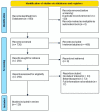
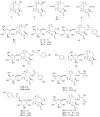






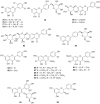
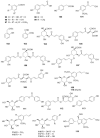
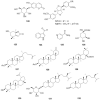
Similar articles
-
The ethnobotany, phytochemistry, and biological properties of genus Phagnalon (Asteraceae): a review.Nat Prod Res. 2023 Jun;37(12):2083-2097. doi: 10.1080/14786419.2022.2112039. Epub 2022 Aug 17. Nat Prod Res. 2023. PMID: 35975749 Review.
-
Phytochemistry and pharmacology of the genus Drypetes: A review.J Ethnopharmacol. 2016 Aug 22;190:328-53. doi: 10.1016/j.jep.2016.06.060. Epub 2016 Jun 25. J Ethnopharmacol. 2016. PMID: 27353868 Review.
-
The genus Inula and their metabolites: from ethnopharmacological to medicinal uses.J Ethnopharmacol. 2014 Jun 11;154(2):286-310. doi: 10.1016/j.jep.2014.04.010. Epub 2014 Apr 19. J Ethnopharmacol. 2014. PMID: 24754913
-
Ethnobotany, phytochemistry, and pharmacology of the genus Litsea: An update.J Ethnopharmacol. 2016 Apr 2;181:66-107. doi: 10.1016/j.jep.2016.01.032. Epub 2016 Jan 23. J Ethnopharmacol. 2016. PMID: 26812679 Review.
-
The ethnobotany, phytochemistry and biological properties of genus Ferulago - A review.J Ethnopharmacol. 2021 Jun 28;274:114050. doi: 10.1016/j.jep.2021.114050. Epub 2021 Mar 20. J Ethnopharmacol. 2021. PMID: 33753144 Review.
Cited by
-
Alpine Adaptive Mechanism on Rhizosphere Microbes Recruitment of Crepis napifera (Franch.) Babc. by Multi-Omics Analysis.Biology (Basel). 2025 Mar 27;14(4):345. doi: 10.3390/biology14040345. Biology (Basel). 2025. PMID: 40282210 Free PMC article.
-
Evaluation of tea (Camellia sinensis L.) phytochemicals as multi-disease modulators, a multidimensional in silico strategy with the combinations of network pharmacology, pharmacophore analysis, statistics and molecular docking.Mol Divers. 2023 Feb;27(1):487-509. doi: 10.1007/s11030-022-10437-1. Epub 2022 May 10. Mol Divers. 2023. PMID: 35536529 Free PMC article.
-
A Bio-Guided Screening for Antioxidant, Anti-Inflammatory and Hypolipidemic Potential Supported by Non-Targeted Metabolomic Analysis of Crepis spp.Molecules. 2022 Sep 20;27(19):6173. doi: 10.3390/molecules27196173. Molecules. 2022. PMID: 36234710 Free PMC article.
-
A Floristic Survey of Wild Edible Plants in Tuscan Maremma, Italy.Plants (Basel). 2025 Mar 20;14(6):976. doi: 10.3390/plants14060976. Plants (Basel). 2025. PMID: 40265923 Free PMC article.
References
-
- Kilian N., Gemeinholzer B., Lack H.W. Cichorieae. In: Funk V.A., Susanna A., Stuessy T.F., Bayer R.J., editors. Systematics Evolution, and Biogeography of Compositae. International Association for Plant Taxonomy; Bratislava, Slovakia: 2009. pp. 343–383.
-
- Bremer K. Asteraceae, Cladistics and Classification. Timber Press; Portland, OR, USA: 1994.
-
- The Plant List. [(accessed on 10 January 2022)]. Available online: http://www.theplantlist.org/
-
- Babcock E.B. The Genus Crepis. Part One: The Taxonomy, Phylogeny, Distribution and Evolution of Crepis. University of California Press; Oakland, CA, USA: 1947.
-
- Enke N., Gemeinholzer B. Babcock revisited: New insights into generic delimitation and character evolution in Crepis L. (Compositae: Cichorieae) from ITS and MatK sequence data. Taxon. 2008;57:756–768. doi: 10.1002/tax.573008. - DOI
Publication types
Grants and funding
LinkOut - more resources
Full Text Sources
Molecular Biology Databases

